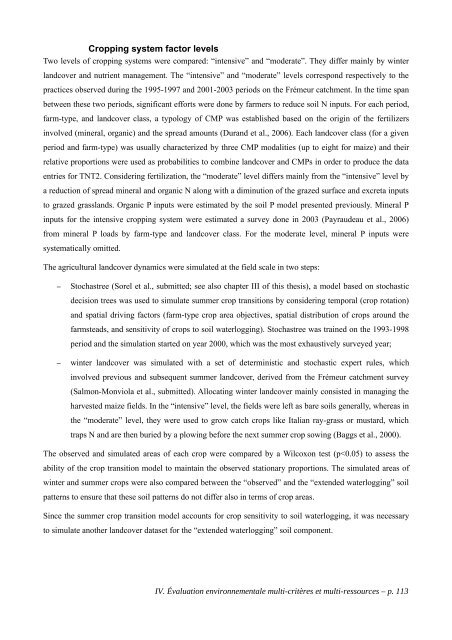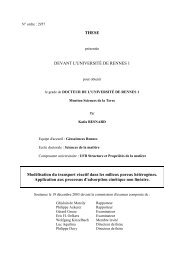Paysages virtuels et analyse de scénarios pour évaluer les impacts ...
Paysages virtuels et analyse de scénarios pour évaluer les impacts ...
Paysages virtuels et analyse de scénarios pour évaluer les impacts ...
You also want an ePaper? Increase the reach of your titles
YUMPU automatically turns print PDFs into web optimized ePapers that Google loves.
Cropping system factor levels<br />
Two levels of cropping systems were compared: “intensive” and “mo<strong>de</strong>rate”. They differ mainly by winter<br />
landcover and nutrient management. The “intensive” and “mo<strong>de</strong>rate” levels correspond respectively to the<br />
practices observed during the 1995-1997 and 2001-2003 periods on the Frémeur catchment. In the time span<br />
b<strong>et</strong>ween these two periods, significant efforts were done by farmers to reduce soil N inputs. For each period,<br />
farm-type, and landcover class, a typology of CMP was established based on the origin of the fertilizers<br />
involved (mineral, organic) and the spread amounts (Durand <strong>et</strong> al., 2006). Each landcover class (for a given<br />
period and farm-type) was usually characterized by three CMP modalities (up to eight for maize) and their<br />
relative proportions were used as probabilities to combine landcover and CMPs in or<strong>de</strong>r to produce the data<br />
entries for TNT2. Consi<strong>de</strong>ring fertilization, the “mo<strong>de</strong>rate” level differs mainly from the “intensive” level by<br />
a reduction of spread mineral and organic N along with a diminution of the grazed surface and excr<strong>et</strong>a inputs<br />
to grazed grasslands. Organic P inputs were estimated by the soil P mo<strong>de</strong>l presented previously. Mineral P<br />
inputs for the intensive cropping system were estimated a survey done in 2003 (Payrau<strong>de</strong>au <strong>et</strong> al., 2006)<br />
from mineral P loads by farm-type and landcover class. For the mo<strong>de</strong>rate level, mineral P inputs were<br />
systematically omitted.<br />
The agricultural landcover dynamics were simulated at the field scale in two steps:<br />
– Stochastree (Sorel <strong>et</strong> al., submitted; see also chapter III of this thesis), a mo<strong>de</strong>l based on stochastic<br />
<strong>de</strong>cision trees was used to simulate summer crop transitions by consi<strong>de</strong>ring temporal (crop rotation)<br />
and spatial driving factors (farm-type crop area objectives, spatial distribution of crops around the<br />
farmsteads, and sensitivity of crops to soil waterlogging). Stochastree was trained on the 1993-1998<br />
period and the simulation started on year 2000, which was the most exhaustively surveyed year;<br />
– winter landcover was simulated with a s<strong>et</strong> of d<strong>et</strong>erministic and stochastic expert ru<strong>les</strong>, which<br />
involved previous and subsequent summer landcover, <strong>de</strong>rived from the Frémeur catchment survey<br />
(Salmon-Monviola <strong>et</strong> al., submitted). Allocating winter landcover mainly consisted in managing the<br />
harvested maize fields. In the “intensive” level, the fields were left as bare soils generally, whereas in<br />
the “mo<strong>de</strong>rate” level, they were used to grow catch crops like Italian ray-grass or mustard, which<br />
traps N and are then buried by a plowing before the next summer crop sowing (Baggs <strong>et</strong> al., 2000).<br />
The observed and simulated areas of each crop were compared by a Wilcoxon test (p



